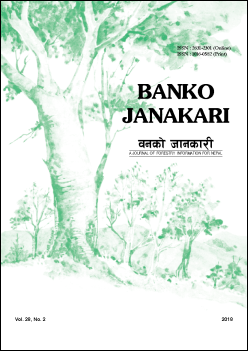Local people’s perception and awareness of climate change: a case study from community forests in Lamjung District, Western Nepal
DOI:
https://doi.org/10.3126/banko.v28i2.24189Keywords:
CFUGs, climate change, impact, perceptionAbstract
Climate change has negatively impacted the underdeveloped and developing countries including Nepal due to low adaptive capacity and higher dependency in agriculture. Forests are important component of the lives and livelihoods of the community in Nepal, which can offer an important source of climate-resilient livelihood. It is crucial to know the fact that climate change was in the past, which will continue to change in the future. It is essential to understand how communities perceive and adapt to climate change. A study was carried out in Kirepani, Jagreni and Kalika Community Forest User Groups (CFUGs) in Lamjung District with an objective of assessing their perceptions on impacts of climate change. The survey was carried out in 62 households along with participatory appraisal to understand the perception of local people on climate change and its impacts. Focus group discussion was held in each CFUG. Climatic data of 29 years (1987–2015) acquired from Khudi, Kuncha and Gharedgunga metereological stations and analysed to supplement the results. Data were analysed using MS-Excel as major computer software and presented as table, trend lines and graphs. The study showed that the locals correctly perceived change in temperature, unpredictable occurrence of rainfall and increased incidence of change in crops phenology, an increase in drought. Based on the perceptions of the community forest users, climate change has affected the biodiversity and societal system differentially. Drought has higher impact to the people affecting their lives and livelihoods. They perceived that the increase in drought, floods, landslide have affected their lives and livelihoods. The results revealed that minimum temperature was increased at the rate of 0.01º C per year whereas the maximum temperature was increased by 0.056° C per year. From the rainfall data of Khudi meteorological station, it was found that annual rainfall was highly decreased at the rate of 25.8 mm per year, which alarms for more disaster such as drought and fire in the area. Our findings suggest that for the innovative climate change adaptation planning and policy it is crucial to incorporate and acknowledge the role of community forest in climate change adaptation.
Downloads
Downloads
Published
How to Cite
Issue
Section
License
© Forest Research and Training Centre, Ministry of Forests and Environment, Nepal




